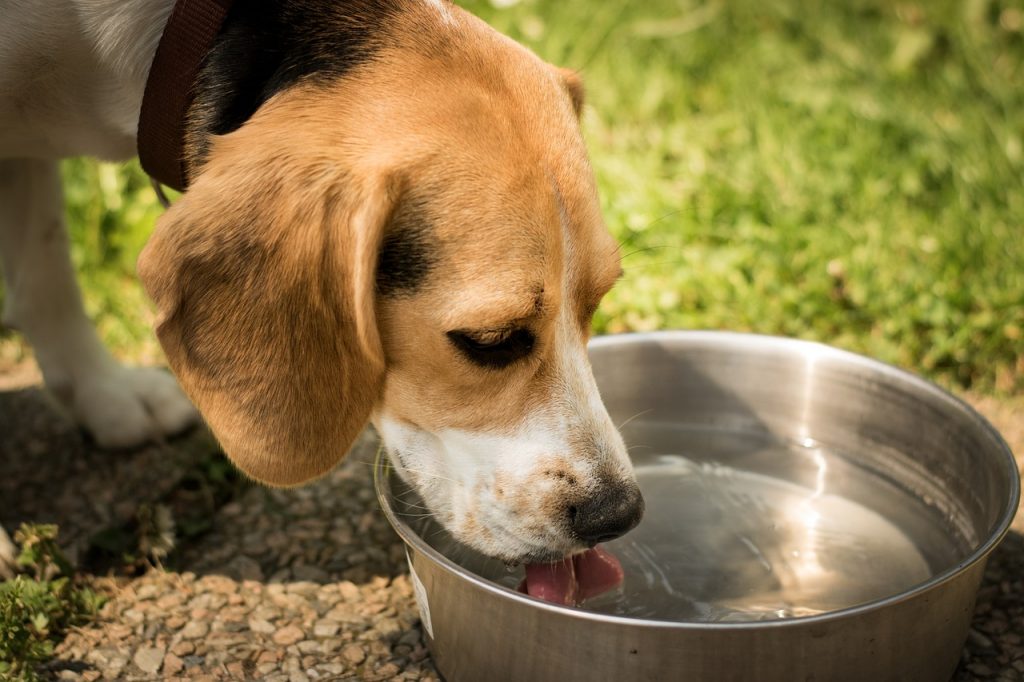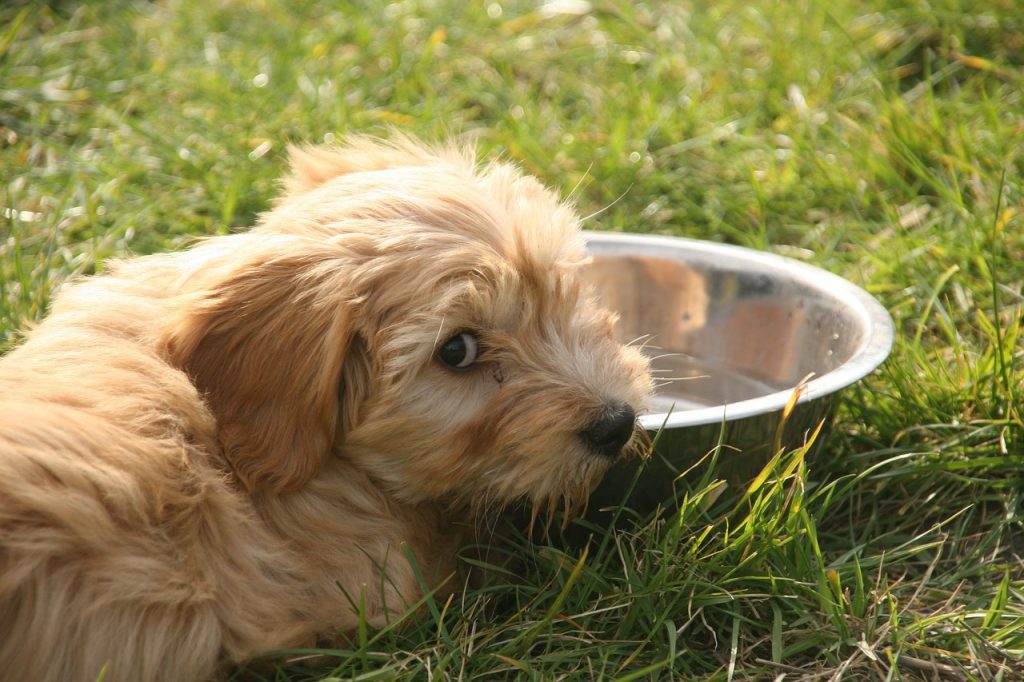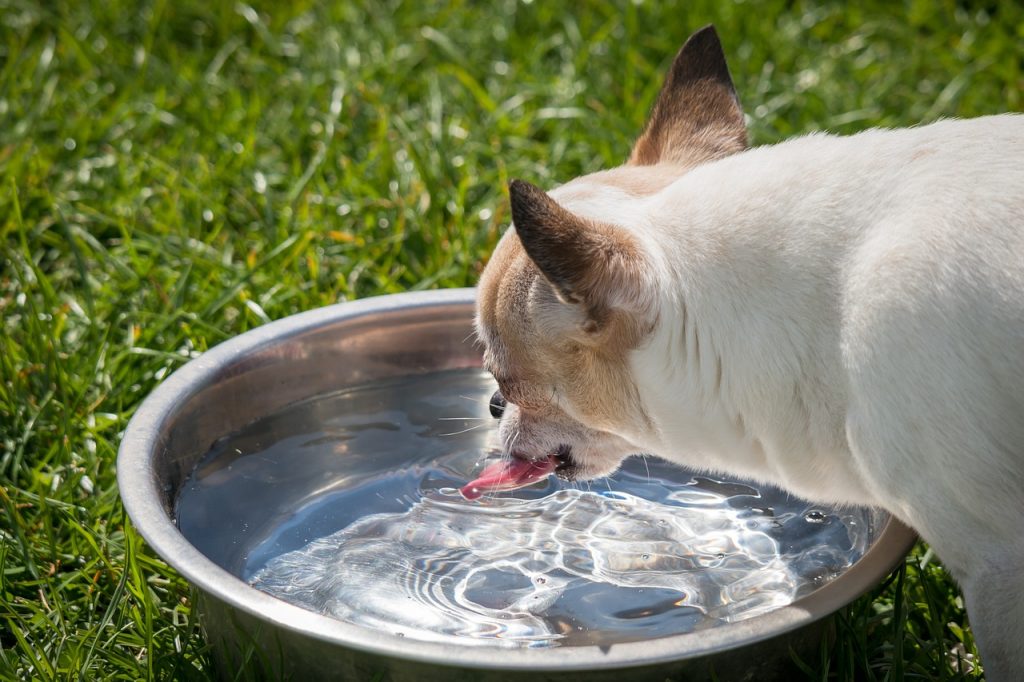Are you noticing your furry friend lapping up more water than usual? Excessive drinking in dogs can be a sign of various underlying health problems like diabetes or kidney failure. How to stop dog from drinking too much water?
Our guide helps dog owners recognize and understand excessive thirst in their pooches, offering tips to manage it effectively. Let’s dive in to ensure your canine companion stays healthy and hydrated just right!

Key Takeaways
- Excessive drinking in dogs may be a sign of underlying health problems like diabetes or kidney failure.
- Dogs should drink about 1 ounce of water per pound of their weight each day to stay hydrated.
- Factors like weather, exercise level, and diet can affect a dog’s water intake.
- It is important to monitor your dog’s water consumption and consult a veterinarian if you notice significant changes.
Why Do Dogs Drink So Much Water?
Dogs drink so much water for various reasons, including normal drinking habits, underlying health conditions, and external factors like diet, exercise, and environment.
Normal drinking habits
Dogs need water every day. Just like humans, dogs use water for their body to work right. Dogs drink about 1 ounce of water per pound of their weight each day. This is normal. The amount can change with the weather and how active a dog is during the day.
It’s good to always have fresh water ready for your dog to drink when it needs it. This helps keep them healthy and happy!
Underlying health conditions
Excessive thirst or increased water intake in dogs can be a sign of underlying health conditions. These health issues may include diabetes, Cushing’s disease, cancer, or kidney failure.
When your dog drinks too much water, it could mean that something is not right with their body. It’s important to pay attention to this and consult a veterinarian if you notice any significant changes in your dog’s water intake.
Some common diseases that can cause excessive drinking in dogs are kidney failure and diabetes. Remember, monitoring your dog’s water consumption is crucial for their overall well-being.
External factors like diet, exercise, and environment
The amount of water a dog drinks can be influenced by external factors such as their diet, exercise level, and environment. For example, if your dog eats dry food, they may naturally drink more water to stay hydrated.
Similarly, dogs that are active or spend a lot of time outdoors in hot weather will need to drink more water to cool down and prevent dehydration. On the other hand, dogs that are less active or live in cooler environments may not need as much water.
It’s important to consider these factors when monitoring your dog’s water intake and make sure they have access to clean drinking water at all times.

How Much Water Should a Dog Drink?
Factors such as size, age, activity level, and weather conditions can affect a dog’s water intake on a daily basis.
Factors that affect water intake
Various factors can influence the amount of water a dog drinks. One important factor is the weather – dogs may drink more when it’s hot to cool themselves down. Exercise level also plays a role, as active dogs tend to drink more water to stay hydrated.
The type of diet and food ingredients can affect thirst too; for example, dry kibble may make dogs feel thirsty compared to wet food. Additionally, certain medical conditions like diabetes or kidney failure can cause excessive thirst in dogs.
It’s essential to monitor your dog’s water intake and consult a veterinarian if you notice any drastic changes in their drinking habits. Remember, on average, a dog should drink about 1 ounce of water per pound of body weight per day.
Daily recommended amounts
Dogs need to drink a certain amount of water every day to stay hydrated and healthy. The daily recommended amount of water for a dog is about 1 ounce per pound of body weight. So, if your dog weighs 20 pounds, they should drink around 20 ounces of water each day.
This may vary depending on factors like weather, exercise levels, and diet. It’s important to monitor your dog’s water intake and make sure they are drinking enough to stay hydrated.
If you notice any significant changes in their drinking habits or they are drinking excessively, it’s best to consult with a veterinarian for further guidance. Remember that proper hydration is essential for your dog’s overall well-being.
Addressing Excessive Drinking in Dogs
To address excessive drinking in dogs, it is important to monitor their water consumption, identify potential causes, and consult with a veterinarian for further guidance.
Monitoring water consumption
It is important to monitor your dog’s water consumption to ensure they are drinking an appropriate amount. Keep track of how much water your dog drinks each day, especially if you notice any sudden changes in their intake.
Excessive thirst or increased water intake could be a sign of underlying health issues and should prompt a visit to the veterinarian. Pay attention to any other symptoms your dog may be experiencing, such as increased urination or changes in behavior.
By monitoring their water consumption closely, you can catch any potential problems early and get the necessary treatment for your furry friend.
Identifying potential causes
Excessive drinking in dogs can be caused by various factors. It’s important to pay attention and identify the potential causes behind your dog’s increased water intake. One common cause is a change in weather, especially during hot or humid days when dogs tend to drink more to stay hydrated.
Another possibility is exercise; if your dog has been very active, they may drink more water to replenish fluids lost through panting and sweating. Diet can also play a role – certain foods can make dogs feel thirsty or even lead to excessive thirst.
It’s important to consider any underlying health conditions as well, such as kidney problems or diabetes, which can cause increased thirst in dogs. By monitoring your dog closely and consulting with a veterinarian, you can help pinpoint the potential causes of excessive drinking and take appropriate action.
Consulting with a veterinarian
If you notice that your dog is drinking a lot of water, it’s important to consult with a veterinarian. They can help determine if excessive thirst is a sign of an underlying health condition.
The vet will examine your dog and ask questions about their habits and behavior. They may also run tests to check for any medical issues that could be causing the increased water intake.
It’s important to reach out to a professional so they can provide guidance and ensure your dog stays healthy.

Tips for Reducing Excessive Drinking
Encourage adequate exercise and hydration, provide a balanced diet on a consistent schedule, create a stress-free environment, and seek veterinary guidance to address underlying medical conditions – all essential steps in reducing excessive drinking in dogs.
Read more for expert tips on promoting your dog’s health and well-being.
Adequate exercise and hydration
Make sure your dog gets enough exercise and stays hydrated. Regular exercise helps to regulate their body temperature and promotes overall health. It also increases water intake, which can help prevent excessive thirst.
Make sure your dog always has access to clean and fresh water throughout the day to stay properly hydrated.
Proper diet and feeding schedule
Giving your dog a proper diet and following a consistent feeding schedule can help reduce excessive drinking. Make sure to provide high-quality dog food that is appropriate for your dog’s age, size, and specific nutritional needs.
Avoid feeding them too many salty or processed foods, as these can increase thirst. It’s also important to establish a regular feeding routine to promote healthy digestion and hydration levels in your dog.
By providing balanced meals at consistent times throughout the day, you can help regulate their water intake and prevent excessive drinking.
Avoiding over -stimulation
To help reduce excessive drinking in dogs, it’s important to avoid over-stimulating them. Dogs can get excited easily, which can make them drink more water than usual. Keep a calm and peaceful environment for your dog by minimizing loud noises and chaotic activities.
This will help prevent your dog from becoming overly stimulated and drinking excessive amounts of water. Additionally, providing regular exercise can also help keep your dog physically and mentally balanced, reducing the likelihood of over-drinking.
Remember that an emotionally stable dog is less likely to experience behavioral issues related to excessive thirst.
Treating underlying medical conditions
If you suspect that your dog’s excessive drinking is due to an underlying medical condition, it’s important to consult with a veterinarian. They will be able to perform the necessary tests and examinations to identify any health issues that may be causing the increased thirst.
Common medical conditions that can lead to excessive drinking include diabetes, kidney disease, and Cushing’s disease. Once the underlying condition is diagnosed, your vet will recommend appropriate treatment options.
Remember, early detection and treatment of these conditions can greatly improve your dog’s overall health and well-being.
Ensuring a stress-free environment
Creating a stress-free environment for your dog is crucial in reducing excessive drinking. Dogs are sensitive to their surroundings, and stress can lead to increased water intake. Make sure your dog has a comfortable and quiet space where they can relax and feel safe.
Provide them with plenty of mental and physical stimulation through toys, games, and regular exercise. Stick to a consistent routine for feeding, exercise, and bedtime to help reduce anxiety.
Additionally, avoid loud noises or sudden changes that may cause stress for your furry friend. By creating a calm and predictable environment, you can help minimize excessive drinking in dogs.

Conclusion
In conclusion, it’s important to monitor your dog’s water intake and address excessive drinking as soon as possible. Excessive thirst in dogs can be a sign of an underlying health issue that needs attention.
By providing proper exercise, a balanced diet, and a stress-free environment, you can help reduce excessive drinking in your furry friend and ensure their overall well-being. Remember to consult with your veterinarian for guidance specific to your dog’s needs.
FAQs
1. What does excessive water drinking in dogs mean?
Excessive water drinking in dogs, also known as polydipsia in dogs, means your dog is drinking more than normal. This could be a symptom of many health issues.
2. Why is my older dog drinking so much water?
Increased water consumption in older dogs might be due to various health problems. It’s best to speak with your vet if you notice a sudden increase in your senior pet’s water intake.
3. How can I handle my dog’s excessive thirst?
You can manage excessive thirst in female and male dogs by knowing the signs of alcohol intoxication and reviewing changes like winter affecting your dog’s hydration levels or habits such as paw licking.
4. Can a lot of drinking harm my dog?
Yes, too much drink for canines might lead to dehydration or alarming health consequences such as canine alcoholism or alcohol poisoning among other things.
5. Are there ways to lessen my dog’s heavy drinking?
Training techniques are available to reduce the heavier-than-normal drink need of pets at home with tips provided by vets on handling this issue effectively.
6. How do I ensure safe and responsible pet ownership regarding drinks?
Preventing access to harmful substances around the house while promoting holistic approaches helps ensure responsible pet ownership when dealing with canine hydration.


